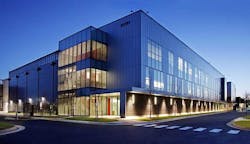Equinix will house a system of lasers to beam data around the globe, using satellites to transfer data across space at high speeds, the company said today. The laser system from Laser Light Communications will be installed in the company’s newest data center in Virginia, and will move international data across space rather than through undersea cables.
The agreement with Laser Light Communications makes Equinix an early player in the field of space-based laser technology, known as free space optics, which was initially developed for use by the Department of Defense and national space agencies. Laser Light will deploy its initial point of presence (PoP) in the Equinix DC-11 data center in Ashburn, Virginia, and then add PoPs in Equinix facilities in the UK, Japan, Brazil, Australia, the Middle East, and Europe.
Laser Light plans to use free space optics to connect to a network of satellites in medium-earth orbit, about 10,000 miles above the earth. Data will beam up and down from the satellites at 100Gbps, while data can travel between satellites at 200Gbps. The resulting HALO all-optical network will bring together terrestrial fiber, a constellation of 8 to 12 satellites, and the Equinix data center network.
“We are excited to work with Laser Light as the interconnection provider for this cutting-edge satellite technology that greatly increases access to many parts of the world that are underserved by current fiber and wireless networks,” said Ihab Tarazi, chief technology officer, Equinix. “By adding ‘SpaceCable’ as an equivalent offering together with terrestrial and submarine cables, Equinix customers looking for low latency solutions to reach new or emerging markets will have access to a full suite of data transport options.”
The emerging technology could be useful in bringing Internet connectivity to areas that are underserved by current undersea cables and terrestrial fiber. Lasers are among a number of new technologies hoping to bring wireless connectivity to the developing world, using everything from balloons to drones to satellites. These initiatives have major implications for where data centers are located and how they’re built and powered.
Table Stakes in New Connectivity Technology
With Laser Light, Equinix gains a tenant that will lease space in multiple data centers across its footprint, but also a foot in the door on a new technology that could fill the gaps in global connectivity plans.
Lasers concentrate a beam of light of a single color (monochromatic) that can carry data. They can be used as weapons (as in James Bond movies) but are more commonly seen in tasks like eye surgery or reading data from an optical disk (Blu Ray) or barcode scanners.
Lasers can transmit a large capacity of data, which provides advantages over traditional satellite communications using radio waves. Using medium-earth orbit satellites offers lower latency than geosynchronous satellites commonly used for TV transmissions, which are more than 22,000 miles from the earth and thus involve a longer round-trip for the data.
“The benefit of a laser-based network is the increased volume that comes from optical versus (Radio Frequency) RF,” Robert Brumley, CEO of Laser Light, recently told Via Satellite. “You can get approximately 1,000 times more data capacity in an optical frequency band than you can with an RF system.”
Working Around the Weather
The challenge is that lasers can be affected by weather, and thus typically require backup via terrestrial systems. This is also an issue with microwave signals, which have been used to provide straight-line data transmission for high-frequency traders. At least initially, space lasers are likely to be a solution for areas that have poor coverage, or in use cases suitable for an intermittent connection.
Free space optics technology has been developed through 20 years of civil science and federal investments and deployments by government entities such as Department of Defense (DOD), National Aeronautics and Space Administration (NASA), European Space Agency (ESA) and Japanese Space Agency (JSA). It is now being commercialized for the first time by private firms, including Laser Light.
With its deployment at DC11, Laser Light will commence installation, testing and demonstration of its leading-edge laser communications and SD-WAN equipment.
Network cabling fills fiber trays inside an Equinix data center. (Photo: Equinix)
The equipment will include a ground node to receive satellite communications, which could be either on the roof of DC-11, on nearby or atop a microwave tower. The ground node requires a clear line of sight to the satellite constellation, and a fiber connection into the data center.Optical networking equipment will receive and transfer the satellite signal, as it would with an undersea cable or fiber. In this case, Laser Light will install software-defined networking (SDN) gear on each end to ensure an “all SDN” data transfer.
Laser Light’s SpaceCable offering will offer services to carriers, enterprises and government customers through Equinix facilities around the globe. Laser Light says it hybrid satellite-terrestrial network will be capable of connecting any two points on the globe with 100Gbps service links.
Laser Light is partnering with Autralia’s Optus, which will provide the constellation of satellites, which should be completed in 2018. Optus also operates a terrestrial network, and says the space lasers can help provide broadcast. mobile and Internet services to remote areas of Australia, New Zealand and Antarctica. Among other businesses, Optus provides dedicated connectivity for mining operations in the Australian Outback.
Equinix operates 145 data centers across 40 countries. Tapping into Equinix provides Laser Light with potential business from more than 1,400 networks and 2,500 cloud and IT service providers.
Equinix Offers Marketplace Access
“A partnership with Equinix permits Laser Light to become a truly tier 1 global carrier with access to facilities, and incumbent local fiber providers, in a ‘one stop shop’ partnership,” said Brumley. “Also, Equinix’s mix of enterprise, global carriers, and government customers, permits Laser Light to be present in the marketplace for high volume data services in the key regional markets around the globe.”
There are challenges in using space lasers, but some analysts see the potential for free space optics to become a viable part of the global connectivity solution, particularly as new technologies bring massive volumes of data onto the network.
“With 60 billion devices connected to the internet by 2020, petabyte level processing, and zettabyte level data growth, global networks face being imperiled by the sheer onslaught of massive data traffic,” said Maureen Rhemann, Senior Strategist at Trends Digest. “Lasercom is the most viable solution because it’s rapidly deployable, secure, can be optically integrated ubiquitously with terrestrial and satellite networks, and has proven its resiliency and reliability for high speed transport of large data sets. Like the evolution of cloud computing, lasercom is the next logical progression in communications transport technology and firms like Laser Light are leading the pack.”
About the Author



